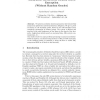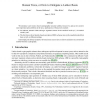106
click to vote
ACNS
2010
Springer
15 years 4 months ago
2010
Springer
Verifiably encrypted signature schemes (VES) allow a signer to encrypt his or her signature under the public key of a trusted third party, while maintaining public signature verifi...
102
click to vote
CRYPTO
2006
Springer
15 years 4 months ago
2006
Springer
We present an identity-based cryptosystem that features fully anonymous ciphertexts and hierarchical key delegation. We give a proof of security in the standard model, based on the...
91
Voted
ASIACRYPT
2006
Springer
15 years 4 months ago
2006
Springer
Abstract. Recently, Bellare and Palacio succeeded in defining the plaintext awareness, which is also called PA2, in the standard model. They propose three valiants of the standard ...
99
Voted
ACISP
2006
Springer
15 years 4 months ago
2006
Springer
The only known construction of identity-based signatures that can be proven secure in the standard model is based on the approach of attaching certificates to non-identity-based si...
113
click to vote
PQCRYPTO
2010
15 years 4 months ago
2010
Abstract. We propose a variant of the “bonsai tree” signature scheme, a latticebased existentially unforgeable signature scheme in the standard model. Our construction offers ...
84
Voted
EUROCRYPT
2010
Springer
15 years 5 months ago
2010
Springer
We introduce a new lattice-based cryptographic structure called a bonsai tree, and use it to resolve some important open problems in the area. Applications of bonsai trees include...
PKC
2005
Springer
15 years 6 months ago
2005
Springer
Abstract. We define and discuss symmetric subgroup membership problems and their properties, including a relation to the Decision DiffieHellman problem. We modify the Cramer-Shoup...
110
Voted
CCS
2005
ACM
15 years 6 months ago
2005
ACM
We describe a new encryption technique that is secure in the standard model against adaptive chosen ciphertext (CCA2) attacks. We base our method on two very efficient Identity-Ba...
113
Voted
PKC
2007
Springer
15 years 6 months ago
2007
Springer
Abstract. Key-insulated cryptography is a crucial technique for protecting private keys. To strengthen the security of key-insulated protocols, Hanaoka, Hanaoka and Imai recently i...
87
Voted
CRYPTO
2007
Springer
15 years 6 months ago
2007
Springer
The common random string model introduced by Blum, Feldman and Micali permits the construction of cryptographic protocols that are provably impossible to realize in the standard m...






